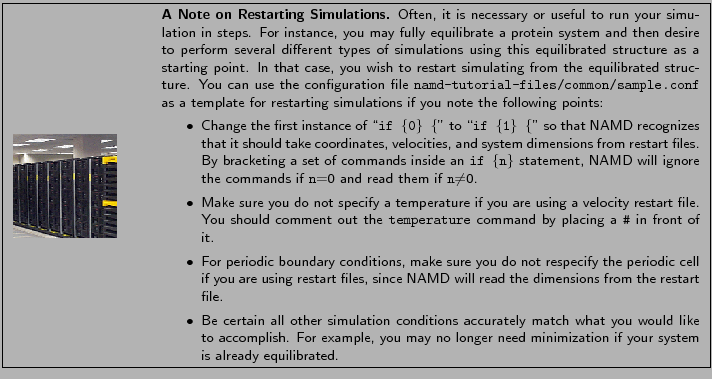
In this section, you will examine the minimization and equilibration of ubiquitin in a water box with periodic boundary conditions.

The configuration file contains some commands which are different than the water sphere configuration file. Here, these differences are pointed out and explained.
Particle Mesh Ewald (PME) is a useful method for dealing with electrostatic interactions in a system when periodic boundary conditions are present. The Ewald sum is an efficient way of calculating long range forces in a periodic system. The particle mesh is a 3-D grid created in the system over which the system charge is distributed. From this charge, potentials and forces on atoms in the system are determined. As a result, your grid size should be chosen such that it is fine enough to accurately represent the configuration of your system.
Alternatively, one can define the PME grid sizes manually, using PMEGridSizeX, PMEGridSizeY, and PMEGridSizeZ. These set the size of the PME grid along
cellBasisVector1, 2 and 3, respectively (not the ![]() ,
, ![]() , and
, and ![]() directions as implied). For speed in computing Fast Fourier Transforms, PMEGridSizeX should be chosen
so that it can be factorized by 2, 3, or 5. If your cellBasisVector1 = (60, 0, 0), a good choice for PMEGridSizeX might be 64, since 60 Å / 64 = 0.9375 Å and
directions as implied). For speed in computing Fast Fourier Transforms, PMEGridSizeX should be chosen
so that it can be factorized by 2, 3, or 5. If your cellBasisVector1 = (60, 0, 0), a good choice for PMEGridSizeX might be 64, since 60 Å / 64 = 0.9375 Å and
![]() . Note that since cellBasisVector is defined with slightly different values in each direction, the size of the mesh spacing (in length) will be different in each direction.
. Note that since cellBasisVector is defined with slightly different values in each direction, the size of the mesh spacing (in length) will be different in each direction.
Note also that when using the PME method, the command cutoff dictates the separation between long and short range forces for the method; it does not simply turn off interactions.
The following are specifications for the Langevin piston which NAMD allows you to specify.
Note that the commands which specify spherical boundary conditions have been completely removed, since this simulation is using periodic boundary conditions.


